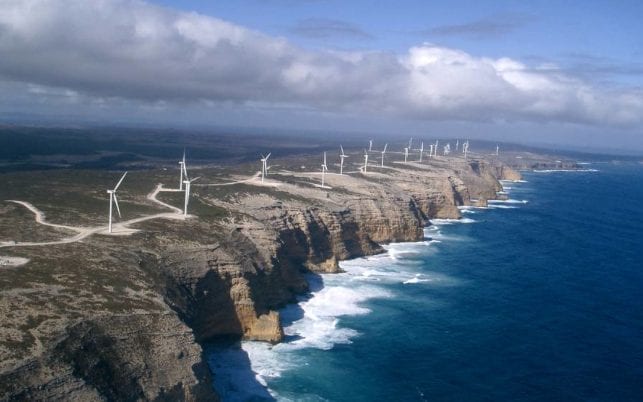Not only has South Australia achieved the highest level of wind energy and rooftop solar in the country, and has cut its emissions by a third in the last few years, its consumers have also had a windfall in generation costs: they are paying generators much less for their electricity than they did before the boom in wind farm and household solar began in 2009.
A study by energy analyst firm Pitt & Sherry finds that in 2012/13, the average South Australian paid generators $88 a year less for the electricity he or she consumed than they did in 2009-10.
And that is even after the introduction of a carbon price. If the impact of the carbon price is taken out, the average price paid per capita to generators in South Australia has fallen by $188 over the last four years – during which time the wind industry has grown from virtually nothing to more than 1,200MW, and rooftop solar has done the same (it is now 400MW).
That’s due to a bunch of reasons. The impact of wind energy – which supplied 27 per cent of the state’s generation in 2012/13, has forced down the price of wholesale electricity. Rooftop solar has had the same impact because it subtracts from demand from the grid, as have more efficient appliances and other energy efficiency measures.
Unfortunately for South Australians, their electricity bills, like those everywhere else in the country, have risen because of the massive investment in grid upgrades and expansions, and because retail margins have also risen. Much of the investment in the grid is now being questioned, particularly as new forecasts show that electricity demand may fall over the coming decade rather than increase as had been assumed previously.
Indeed, in its latest regulatory filings, the SA grid operator has already cancelled virtually all its planned extensions, for savings of around $167 million, according to data provided by the Australian Energy Regulator.
A graph prepared by Pitt & Sherry (see below) shows that because of South Australia’s high renewable share the impact of the carbon price has been relatively low – just $98 on wholesale costs – compared to $179 in the state with the dirtiest electricity production, Victoria.
South Australia now sources 31 per cent of its electricity generation through wind and solar, which has lowered its emissions by one third over the last four years. The coal-fired generators have either been mothballed completely or closed for half the year. Which just goes to show that an ambitious renewables target and a carbon price can deliver cleaner, greener, and cheaper energy.
The Australian Energy Market Operator has predicted that the amount of rooftop solar could triple by 2020. Depending on how much wind energy is built between now and 2020 – and that will depend on whether the new government retains the current renewable energy target – the state’s renewable energy capacity is expected to soar well above 50 per cent by then.
Of the other states, Tasmania (because it is mostly hydro) had the lowest carbon impact of just $43 per capita, while Victoria had the highest courtesy of its brown coal generators, and Queensland and NSW, which both rely heavily on black coal generation, also had high impacts.
However, the impact of falling demand and renewables offset much of these price impacts. In Victoria, which takes a lot of the excess South Australian generation, and where the local energy efficiency program has also had a signficant impact (household consumption is down 10 per cent over the last year according to EnergyAustralia), the fall in wholesale prices represented $124 per capita. That means, even with a carbon price, average payments to generators rose only $55 over the four years.
(It should be noted that the Pitt & Sherry calculations assumed 100 per cent pass-through of costs – not taking into account compensation to brown coal generators. It is calculated the carbon cost component of wholesale prices in each NEM state in 2012-13, based on the emission intensity of electricity supplied in the state).
In NSW, because wholesale prices (net of carbon price) have fallen also due to the impact of renewables and falling demand, there has been no rise in per capita payments by consumers to generators over the past five years.
Queensland and Tasmania experienced significant wholesale cost increases, but these were due to exceptional factors, not directly related to the carbon price.
In Queensland, wholesale prices were the lowest in Australia for some years prior to 2012-13, but a series of disruptive market events (high temperatures, unexpected generator failures, transmission congestion), resulted in very high market prices over extended periods in January and again in March and June.
Pitt & Sherry says that if these prices, net of carbon, been the same as in 2011-12, the net carbon price increase over 2009-10 would have been only $11.
In Tasmania, , electricity flows through BassLink allow wholesale prices in Tasmania to be strongly affected by prices prevailing in the much larger adjoining Victorian market, meaning that Tasmanian prices went up by much more than just the pass-through of the local carbon cost.
Pitt & Sherry’s finding are interesting in the context of the Abbott government’s pledge to repeal the carbon price, and to review the renewable energy target, in the interest of reducing the cost of electricity. It highlights the fact that lower demand and the impact of renewables is actually delivering cheaper electricity, even if it means that generators are suffering because of lower profits.








